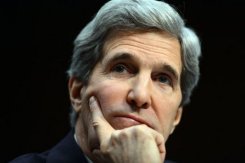
With Kerry in Office, China-US Relations May Change Direction
In the blink of an eye, newly appointed Secretary of State John Kerry has taken office. Will the U.S. readjust its policy toward Asia? Where will China-U.S. relations go from here?
Going back in history, from the end of World War I and World War II, Cold War détente and the establishment of diplomatic relations between China and the U.S. to the end of the Cold War and the international fight against terrorism, adjustments in U.S. foreign policy during these historical turning points are examples of the importance of trade relations overcoming geopolitical factors.
A number of observations follow on the U.S.'s rebalancing strategy in the Asia-Pacific region.
First, the U.S. economy seems to be improving while Europe’s still has not recovered. During the second half of 2012, conflict between China and Japan intensified in East Asia. With its strategic Trans-Pacific Partnership Agreement in 2011, the U.S. launched what participants in the Asian economy see as the highest degree of trade liberalization. The move indicates that the U.S. has not shifted from its stance that "the economic health of the [Asia-Pacific Economic Cooperation] region is vitally important to America's continued prosperity." Rather, the TPP simply highlights the U.S. leadership position in the region.
Second, the adjustment of U.S. foreign policy in Asia is taking place during a global economic downturn. Western economies face an uncertain future while India, China and other emerging economies are developing rapidly. On the one hand, globalization and multipolarization are still the main global trends, and the West retains its dominant position. On the other hand, a structure might emerge where two markets exist side by side in the world economy. For the time being, global gross domestic product shares of developed and emerging-market countries have shifted from a ratio of 60-to-40 to 50-to-50.
Third, the current shift in U.S. Asia-Pacific policy differs from the late stages of the Cold War. Then, the Soviet navy substantially expanded its combat capabilities in the Pacific Ocean, threatening U.S. Asia-Pacific military interests and leading to an alliance with China to counter the Soviet Union. It is also different from the early days of the end of the Cold War when the U.S. implemented a strategy to achieve hegemony in response to the so-called China threat. For now, the U.S. must aim to reduce the scale of its army and its military presence in Europe, strengthen the new military strategy of its allies in the Asia-Pacific region and continue to assume responsibility for maintaining security and prosperity in the region, leading the task of balancing power within Asia. In reality, a sharp opposition emerges between the U.S. maintaining its position of global leadership and its less-than-satisfactory influence in the Asia-Pacific region.
Fourth, as they develop according to this trend, U.S.-China relations will become increasingly multifaceted and complex. Beyond the widely acknowledged bilateral dependence, how should the U.S. respond to the fact that China’s prosperity has brought changes to economic interests in the Asia-Pacific region? How should the U.S. negotiate between allies and East Asian competitors, such as China and Japan and the interests of the two sides of the Taiwan Strait. These issues present the new diplomatic challenges of Kerry’s term.
Protecting the security and prosperity of the Asia-Pacific region remains at the core of U.S. foreign policy in Asia; it is not simply about changing its stance on China. Kerry still faces a fundamental contradiction: the urgency of adjusting the Asia-Pacific strategy with limited U.S. capabilities.
Considering its economic and political need to maintain growth momentum, the U.S. has experienced rapid trade developments in East Asia. As the Obama administration carries out its rebalancing strategy toward security and prosperity in the Asia-Pacific region, the U.S. may place more emphasis on trade and investment with relatively lower security considerations.
The tense security environment on both sides of the Taiwan Strait has lessened recently. More than ever, U.S. participation in East Asian regional economic cooperation requires improved cross-strait relations.
The author is a researcher at the Shanghai Institutes for International Studies.

